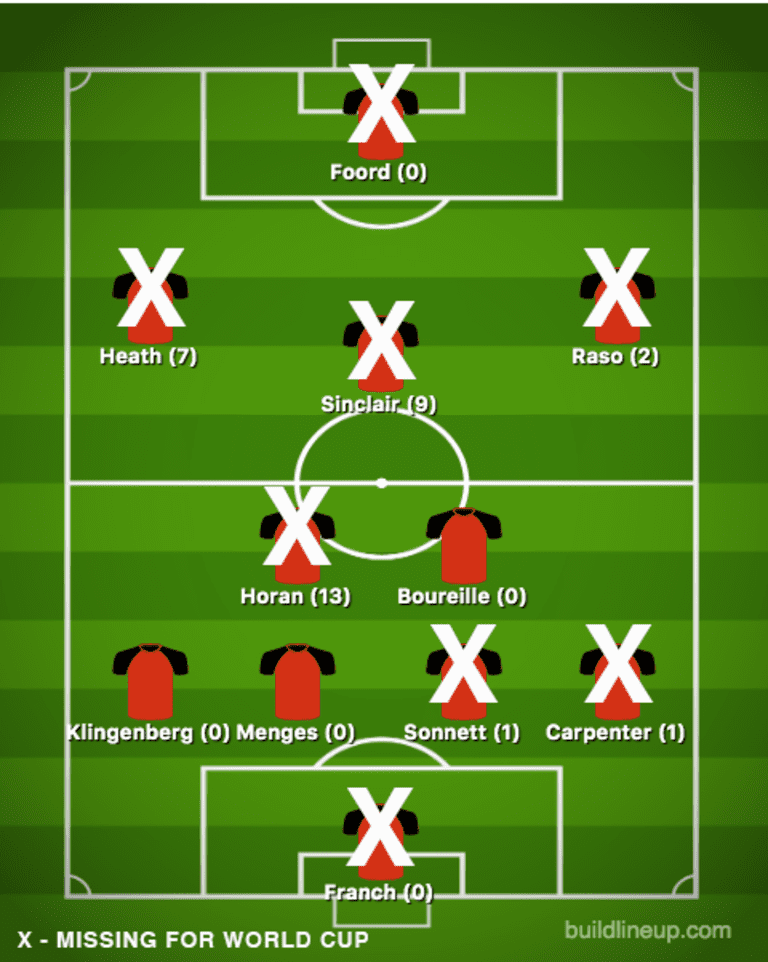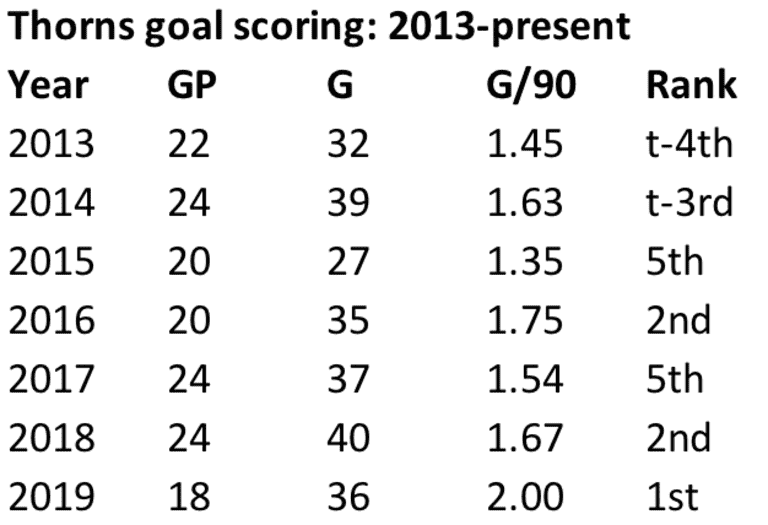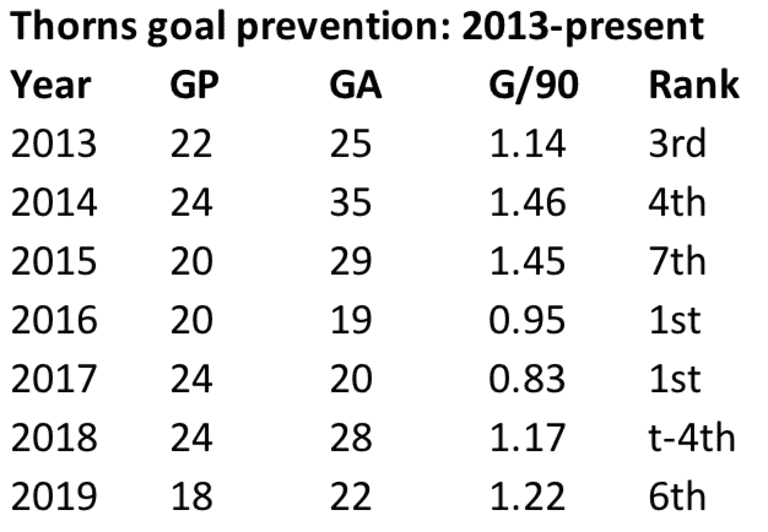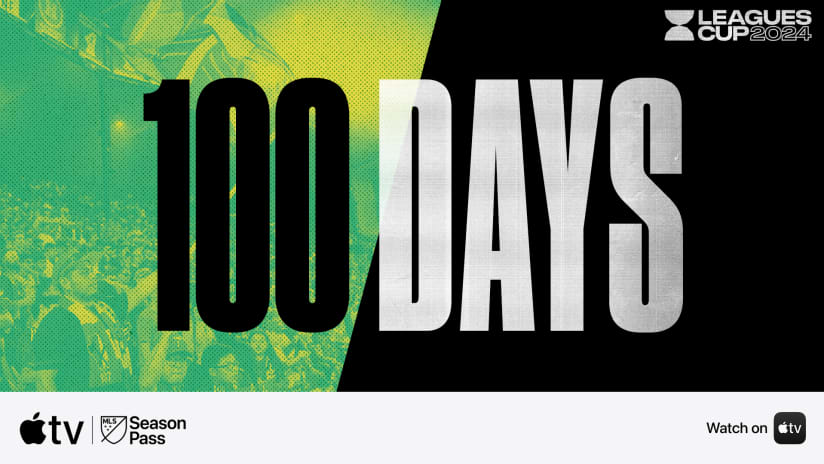Put on your red-and-black-colored glass, think back five months, and try to remember where our heads were when it came to Portland Thorns FC. What were our hopes and dreams for the 2019 season? Where were we finding our excitement? Our curiosity? Our anticipation? What were our greatest fears?
For some, that last question will be easiest to answer. Way back in March, when this year’s Thorns were assembling for the team’s seventh season, the specter of the 2019 World Cup loomed. Still managing nightmares from brutal 2015 season – the worst in team history – fans wondered how a team destined to lose Christine Sinclair, Tobin Heath, Lindsey Horan, Hayley Raso and Caitlin Foord for two months would be able to navigate the season. The more pointed question: How was the team going to score goals?

(X) - goals scored during the 2018 NWSL regular season.
It was a great question. In 2018, Portland scored 40 times in 24 games, good for second in the NWSL. Still, that wasn’t enough to claim a title, a fact that prompted an obvious question: If last year’s attack wasn’t good enough to win it all, and this year’s attack projected to be worse, how were the Thorns going to claim a third NWSL crown?
That worry was more than a rhetorical exercise. Of those 40 goals scored in 2018, 33 of them came from players who’d be gone this summer. Heath, Horan and Sinclair combined for 29 of those, with Raso, Emily Sonnett and Ellie Carpenter claiming for the other four. The 40 goals the team scored in 2018 may have been a club record, but what good was that higher-water mark if 82.5 percent of that production was in France this summer?
Such was the justification for our fears. Now, from the perspective of the aftermath, there’s an entirely different reality. With six games left in the 2019 regular season, Portland has the best attack in the NWSL. With 36 goals through 18 games, the Thorns are the only team in the league that’s averaging two goals per game, forging that mark despite playing a road-heavy schedule at season’s onset with what many would think a decimated lineup from mid-May until July.

How could that possibly happen? Before getting to that, a bit of perspective:
Although the Thorns’ attack has always been blessed with some of the game’s most enviable talents, the team’s best seasons have coincided with excellence in goal prevention, not goal scoring. In head coach Mark Parsons’ first two years in Portland, the Thorns had the league’s best goals-against rate. Both years, the team won a trophy (the league’s Shield in 2016; the NWSL Championship in 2017). Even in 2013, when the team claimed its first title, the performance on the defensive end of the field outpaced the attack. Cindy Parlow Cone’s team finished third in the league in goal prevention; tied for fourth in the league in goals scored.

Only once – during that ill-fated, long-remembered 2015 season – has the team ever finished in the bottom half of the league in goals allowed, something that makes this year’s totals, unfortunately, stand out. It may not seem like it when we’re watching the games, but this year’s Thorns actually have a below-average defense. Their 1.22 goals allowed per 90 minutes is only good enough for sixth out of the league’s nine teams.
That brings us back to the same question we asked, above: How could that possibly happen? The silver lining of the World Cup robbing the team of its marquee attacking talent was supposed to be the players left behind in defense. Sonnett, Carpenter and goalkeeper Adrianna Franch were going to France, but the team still had Emily Menges and Meghan Klingenberg. Katherine Reynolds was coming back off of last year’s season-ending knee injury. Elizabeth Ball had added a year’s experience to her talent, while fellow Penn State product Britt Eckerstrom, going all the way back to her rookie year in Western New York, had proven capable to stepping into a starting lineup.
So, again: How could that – the Thorns morphing from their defense-first, goal-prevention character into a team that outscores opponents – possibly happen? Especially in a year when the attack was supposed to be compromised, but the defense had depth to endure?
First, the defense really isn’t as bad as its league ranking implies. Allowing 1.22 goals per game is higher than Parsons would want, but a bulk of that is attributable to three games: April 20’s draw in Chicago (4-4); May 18’s loss in Washington (1-3); and July 14’s win at home over Orlando (4-3). Ten of the 22 goals the team has allowed this year have been in those games, and while you can’t excuse those matches when evaluating the team’s defense, the fact forces us to hedge in how we describe Portland. The defense is more inconsistent than anything else, with the team allowing only 0.80 goals per game in their other 15 matches, this season.

Second, consider this year’s distribution of goals scored. The six World Cup-bound players who combined for 82.5 percent of the team’s scoring in 2018 have scored 17 times, this year: only 47.2 percent of the team’s goals. Add in players like Foord and Andressinha to account for the full France contingent and the proportion is still smaller than feared. World Cup players have only accounted for 58.3 percent of the Thorns’ goals, this season.
In their place, Midge Purce has stepped up. Big time. By herself, she’s almost scored as many goals (six) as every non-World Cup-bound player did in 2018. Add in the contributions of Tyler Lussi, Marissa Everett, Dagny Brynjarsdottir and Ana-Maria Crnogorcevic – as well as players like Klingenberg and Simone Charley, who each racked up multiple assists in the World Cup period – and you have a level of depth that makes our March fears look foolish. Perhaps we couldn’t have predicted that names like Everett and Charley would have moments this summer, but given the depth in the Thorns’ locker room, we shouldn’t have been so fatalistic about the team’s future, either.
Where you a devil’s advocate, you might argue that, like Portland’s defense, the team’s attacking numbers are influenced by a few big games. And perhaps, that’s true. There was the five-goal game against Houston (July 24); the four-goal games against Chicago and Orlando; and the three-goal games against Orlando (May 11), Chicago (June 2), and Washington (August 17). But when you add in the five other times the team has scored at least two goals, you get a profile that speaks less to the attack’s inconsistency than its norm. More often (11 times) than not (seven), this year, Portland’s been able to score at least two goals.

Those fears of March? They’re beyond the rearview, now. What we’re left with is a landscape where the Thorns are playing like never before, and while Parsons surely would like his defense to get back to the team’s historical standards, to this point in 2019, Portland’s become more likely to win shootouts than grind out results.














